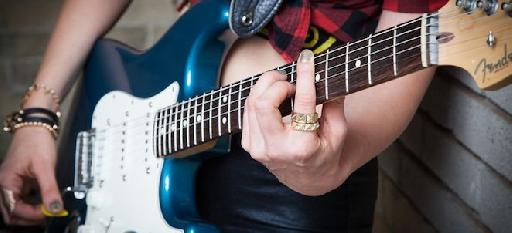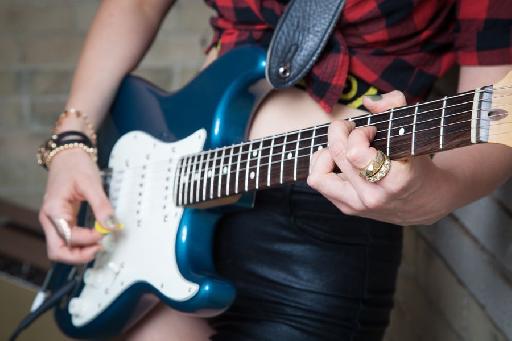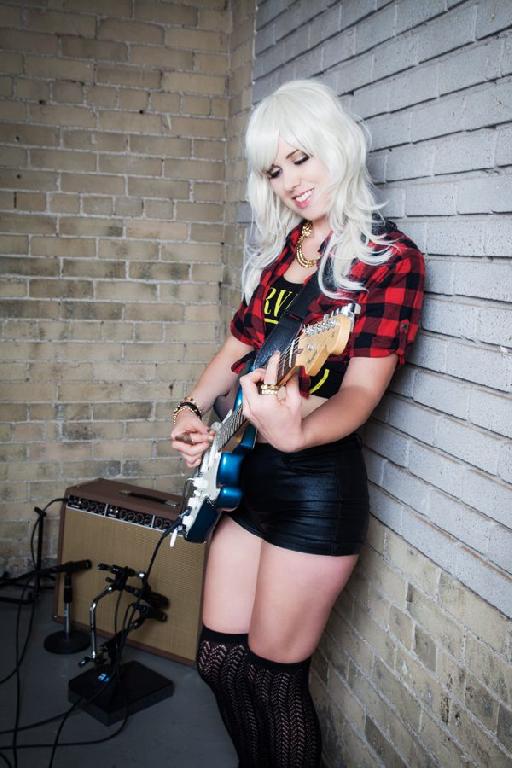| Photography by: Sarah Thomson - www.sarahtphoto.ca Makeup by: Melle Onyschuk Equipment provided by: Morph Productions - http://www.morphproductions.com |
Recording the electric guitar should be a fun experience, and the goal should be to capture the best sound possible. In order to record an amazing sound, you're going to need a great guitar player, a good quality instrument, and possibly an amp, at least one mic and DI. Today's technologies give you a multitude of options on how to go about recording, but your success will still come down to your player, your ears, your tools and how well you know how to utilize them.
Here's a breakdown on the components that will influence your recorded sound.
The Player
To achieve a great recording, it's best to work with a seasoned studio guitar player. Even if the guitarist has played many gigs, their live performance background doesn't guarantee that they'll be able to play perfect takes in the studio. Guitarists who are experienced studio musicians are able to play licks and chord progressions easily, fluidly and at the right time. If you're auditioning guitarists to work with for your next session, evaluate aspects of their playing technique including: how hard the strings are strummed or picked, how cleanly the notes are fretted, their timing and ability to read music (if this is required for the session). Artistic aspects of their playing you should listen for include feel, groove and potentially, the guitarists ability to improvise. In order to record a brilliant session, a great guitar player is the first thing you'll want to find.
Electric Guitars and their Pickups
The type of wood the guitar is built from, the guitar's construction and the pickups used will determine the sound that's emitted from the instrument. The majority of the sound is produced from the pickups on electric guitars. Single coil pickups tend to have a brighter sound, and humbucking pickups have a thicker, more solid sound. The sound produced by humbucker pickups can mask other mid-range sounds, so be aware of this when tracking. Humbucker pickups do have an advantage; they are designed to reject electromagnetic interference, while single-coil pickups can be affected by this. There are specially stacked humbuckers available for those who would like to capture a tone close to the original source, but without the added noise. That being said, electric guitars are fairly noisy instruments, especially when used in combination with an amplifier, distortion and perhaps a few pedals for effects processing. Your guitar and pickup choices should be based on the type of sound you'd like to achieve.
Types of Amps
Guitar amps are made with sealed or open-back cabinets, and typically have 10 to 12 inch speakers. Open-back cabinets tend to have a lower frequency sound than closed ones, as the air does not get trapped inside the back of the amp. The sound produced from the front of the cabinet interacts with the sound produced from behind the cabinet, which causes some frequencies to be enhanced, and others to be cancelled. There are two main types of guitar amps: tube and solid-state. Tube amps use one or more vacuum tubes to amplify the signal, while a solid-state amp uses 'solid state' electronics, (such as diodes, triodes, and capacitors). Many amps are not simply tube or solid-state, but 'hybrids', which means they are a mix of both types. Hybrids usually have a tube preamp stage; they employ vacuum tubes in the tone shaping circuitry, but use solid-state circuitry in the power section.
Tube amps tend to be a little more expensive and require more maintenance, as you need to occasionally replace the tubes. Solid-state amps tend to be less delicate, however players tend to prefer the warm sound of tube amps as they feel they produce a better distorted sound. It's best to try out a few of all of these types of amps in your local shop, and then rent (or purchase) the one that you prefer.
Recording Methods
The traditional method of recording electric guitar is to mike up a really good amp. These days, there are more recording options available, including physical modelling guitar preamplifiers, complete guitar/pickup/amp modelling systems, analog guitar recording pre-amps, or plugging your guitar directly into the computer and using plug-ins to handle the amp and speaker modeling. This article will cover recording electric guitar using an amplifier, and microphones.
Method #1: Miking the Amp
The tried and tested method of recording guitar is still a solid, reliable option.
Once you have your guitar and amp, the next component required is a microphone. If you use good mixing techniques, any decent type of mic can be used to produce good results. Traditionally, both dynamic and capacitor mics are used for recording. Dynamic mics used to record guitars tend to capture the mid-range well and not produce extreme high or low frequencies. When recording guitars, you don't want to capture the really high frequency spectrum (i.e., past 10 k) or the extreme low end, as it will create muddiness in the mix. Capacitor mics produce a brighter, more open sound than dynamic microphones.
It's important to understand that the amp emits sound from the speakers as well as the back and side panel. Open-backed cabinets are capable of producing as much sound from the back of the amp as from the front; this should be kept in mind when making mic position choices.
Here are a few options for mic positions:
'Live' Miking
Set up the amplifier, play loudly, and put the mic several feet away. In this scenario, the mic 'hears' the guitar sound similarly to the way an audience would. Using this method, the sound of the amp is recorded along with the sound of the room. It's a useful method for rooms with good acoustics, or for creating 'live' sounding recordings.
Close-Miking
Position the mic in front of the amp, very close to the speaker cone. If the amp has more than one speaker, move the mic around to find the best sound. Keep moving the mic until you find the best position, and then record.
Two Mics
If there are two mics available, position both mics very closely together, and a few inches away from the speaker cone. It's a good idea to invest in a specialized stand that will hold the two mics steady. Experiment with the mic position to produce the best sound, and keep the microphones in phase with each other. The microphones that are traditionally used for this technique are the Shure SM57, and the Sennheiser 421.
Capturing Ambience
An 'ambience' (or room) mic can be positioned several feet away from the guitar amp and be combined together with the sound of the close mic. It's also possible to combine two close mics together with an ambience mic to capture an even wider scope of sound. Try inverting the phase of the close mic and experiment with delaying the sound of the ambient microphone to achieve new results. In the mix, try panning the recorded guitar tracks left and right, or perhaps even summing the ambient mic to mono. The purpose of the ambience mic is to capture the sound of the room, and a slightly different tone. When it comes to mic choices, a capacitor mic would work for the ambience mic, however any mics that sound good will work for this method. A good mic pairing for this technique would be the Shure SM57, and the Sennheiser 421 for the close mics, and the Neumann U87 for the room mic.
Mic from the Rear
If the amp has an open back, consider setting up the mic (or an additional mic) from the rear. This method will produce a different flavor than miking from the front; the tone will usually sound warmer and may have less high frequencies in the sound. If you are miking the front and rear of the amp, you may have to experiment with switching the phase on the mics. Although this is not a traditional method, it might work for you!
Three Mics
You may want to position the two close mics so that one mic is directly in front of the speaker cone, and the third mic in a different position (e.g. miking the far side of the speaker cabinet). Be open to trying new techniques and observe the difference in sound.
Be Creative
When it comes to recording guitar, almost anything that sounds good goes. Depending on your recording circumstances, you might need to elevate the cabinet to achieve the results you desire. Reflective materials, such as a square of linoleum can be placed under the amp to emphasize reflections. Before you hit the 'record' button, be sure to spend time carefully positioning the microphone, listening to the results, and repositioning again until you discover the sweet spot.
In a future article I'll walk you through a few other methods of recording electric guitar... until then, good luck and happy recording!







 © 2024 Ask.Audio
A NonLinear Educating Company
© 2024 Ask.Audio
A NonLinear Educating Company
Discussion
best beginner guitar
Want to join the discussion?
Create an account or login to get started!